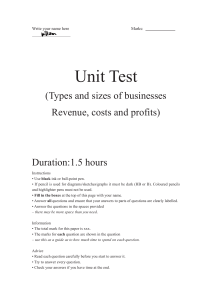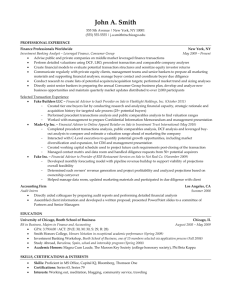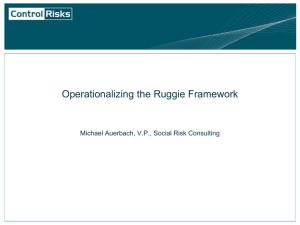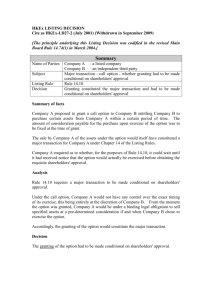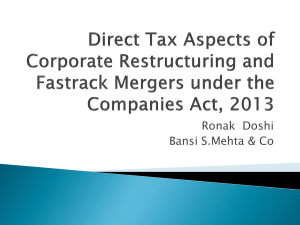Assignment
advertisement
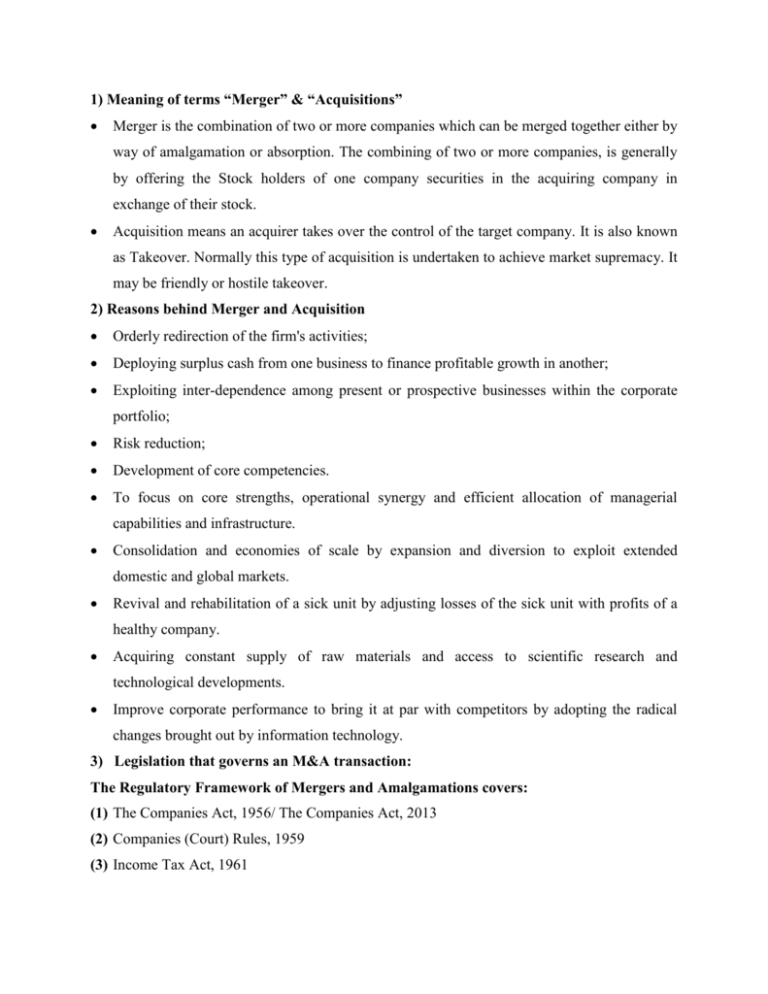
1) Meaning of terms “Merger” & “Acquisitions” Merger is the combination of two or more companies which can be merged together either by way of amalgamation or absorption. The combining of two or more companies, is generally by offering the Stock holders of one company securities in the acquiring company in exchange of their stock. Acquisition means an acquirer takes over the control of the target company. It is also known as Takeover. Normally this type of acquisition is undertaken to achieve market supremacy. It may be friendly or hostile takeover. 2) Reasons behind Merger and Acquisition Orderly redirection of the firm's activities; Deploying surplus cash from one business to finance profitable growth in another; Exploiting inter-dependence among present or prospective businesses within the corporate portfolio; Risk reduction; Development of core competencies. To focus on core strengths, operational synergy and efficient allocation of managerial capabilities and infrastructure. Consolidation and economies of scale by expansion and diversion to exploit extended domestic and global markets. Revival and rehabilitation of a sick unit by adjusting losses of the sick unit with profits of a healthy company. Acquiring constant supply of raw materials and access to scientific research and technological developments. Improve corporate performance to bring it at par with competitors by adopting the radical changes brought out by information technology. 3) Legislation that governs an M&A transaction: The Regulatory Framework of Mergers and Amalgamations covers: (1) The Companies Act, 1956/ The Companies Act, 2013 (2) Companies (Court) Rules, 1959 (3) Income Tax Act, 1961 (4) Listing Agreement (5) The Indian Stamp Act, 1899 (6) Competition Act, 2002 (7) Foreign Exchange Management Act, 1999 4) Meaning of Due Diligence and Professionals involved in Due Diligence. Due Diligence is the process by which confidential legal, financial and other material information is exchanged, reviewed and appraised by the parties to a business transaction, which is done prior to the transaction. “Due diligence” is an analysis and risk assessment of an impending business transaction. It is the careful and methodological investigation of a business or persons, or the performance of an act with a certain standard of care to ensure that information is accurate, and to uncover information that may affect the outcome of the transaction. It is basically a “background check” to make sure that the parties to the transaction have the required information they need, to proceed with the transaction. Due diligence is used to investigate and evaluate a business opportunity. The term due diligence describes a general duty to exercise care in any transaction. As such, it spans investigation into all relevant aspects of the past, present, and predictable future of the business of a target company. Due diligence report should provide information and insight on aspects such as the risks of a transaction, the value at which a transaction should be undertaken, the warranties and indemnities that needs be obtained from the vendor etc. Professionals involved are Chartered Accountants, Company Secretaries, Cost and Management Accountants, Lawyers etc. 5) Role of the professionals and purpose and scope of a Due Diligence Investigation. (1) Role of professionals: Chartered Accountant: Financial Due Diligence which includes review of accounting policies, review of internal audit procedures, quality and sustainability of earnings and cash flow, condition and value of assets, potential liabilities, tax implications of deal structures, examination of information systems to establish the reliability of financial information, internal control systems etc. Company Secretary: legal due diligence which covers the legal aspects of a business transaction, liabilities of the target company, potential legal pitfalls and other related issues. Legal due diligence covers intra corporate and inter corporate transactions. It includes preparation of regulatory checklists meeting with personnel, independent check with regulatory authorities etc. apart from document verification. Advocates: All the information to be checked like financials, tax returns, patents, copyrights and customer base to ensure that the company does not face a lawsuit or criminal investigation. The financials are very important and one needs to be certain that the target company did not engage in creative accounting. The asset position and profitability of the company are vital. (2) Purpose of Due Diligence: The purpose of due diligence is to provide the party proposing the transaction with sufficient information to make a reasoned decision as to whether or not to complete the transaction as proposed. It should provide a basis for determining or validating the appropriate terms and price for the transaction incorporating consideration of the risks inherent in the proposed transaction. (3) Scope of Due Diligence: Scope of due diligence is transaction-based and is depending on the needs of the people who is involved in the potential investments, in addressing key uncovered issues, areas of concern/threat and in identifying additional opportunities. Due diligence is generally understood by the legal, financial and business communities/potential investors to mean the disclosure and assimilation of public and proprietary information related to the assets and liabilities of the business being acquired. This information includes financial, human resources, tax, environmental, legal matters, intellectual property matters etc. Due diligence would include thorough understanding of all the obligations of the target company: debts, rights and obligations, pending and potential lawsuits, leases, warranties, all high and impact laden contracts both inter-corporate and intra-corporate. The investigation or inspection would cover: Compliance with applicable laws Regulatory violations or disciplinary actions Litigation and assessment of feasibility of pursuing litigation financial statements, Assets – real and intellectual property, brand value etc. Unpaid tax liens and/or judgments Past business failures and consequential debt Exaggerated credentials/Fraudulent claims Misrepresentations or character issues Cross-border issues – double taxation, foreign exchange fluctuation, sovereign risk, investment climate, cultural aspects, reputation, goodwill and other intangible assets. (6) Steps involved in an M&A transaction: Check Memorandum whether it authorises Merger, If no Amend it Convene a preliminary Board Meeting Prepare Valuation Report and Swap Ratio Prepare scheme of Amalgamation Convene Board meeting to approve it. Inform Stock the scheme, valuation report, swap ratio Exchanges before meeting and outcome of the meeting Application to the court seeking direction to call general meeting/creditors meeting Inform the Stock Exchanges Report the results of the meeting to the concerned High Court. Petition to the court for Confirmation of the scheme Obtaining court order sanctioning scheme Filing copy of court order with ROC Transfer of assets and liabilities Allotment of shares to shareholders of transferor company Listing of shares at Stock Exchange Post-merger integration 7) Various modes of funding an M&A: Mergers and takeovers may be funded by a company (i) out of its own funds, comprising increase in paid up equity and preference share capital, for which shareholders are issued equity and preference shares or (ii) out of borrowed funds, which may be raised by issuing various financial instruments. (iii) A company may borrow funds through the issue of debentures, bonds, deposits from its directors, their relatives, business associates, shareholders and from public in the form of fixed deposits, (iv) external commercial borrowings, issue of securities, loans from Central or State financial institutions, banks, (v) rehabilitation finance provided to sick industrial companies under the Sick Industrial Companies (Special Provisions) Act, etc. Form of payment may be selected out of any of the modes available such as (a) cash payment, (b) issue of equity shares, (c) mix of equity and cash, (d) debt or loan stock, (e) preference shares, convertible securities, junk bonds etc. Well-managed companies make sufficient profits and retain them in the form of free reserves, and as and when their Board of Director propose any form of restructuring, it is financed from reserves, i.e. internal accruals. Where available funds are inadequate, the acquirer may resort any one or more of the options available for the purpose of raising the required resources. The most prominent routes are the borrowing and issue of securities. The required funds could be raised from banks and financial institutions or from public by issue of debentures or by issue of shares depending upon the quantum and urgency of their requirements. Generally a cash rich companies use their surplus funds for taking over the control of other companies, often in the same line of business, to widen their product range and to increase market share. 8) Demerger, types and reasons for a demerger: Meaning: The expression demerger is not expressly defined in the Companies Act, 1956. However, it is covered under the expression ‘arrangement’ as defined in clause (b) of Section 390 of the Companies Act, 1956. According to this definition, ‘arrangement’ includes a reorganisation of the Share Capital of the Company by the consolidation of shares of different classes, or by the division of shares into shares of different classes or, by both these methods. Such divisions may take place for various reasons internal or external. Internal factors are generally split in family rather than lack of competence on the part of management. The Companies Act does not contain the concept of ‘de-merger’ as such, but indirectly, it does recognize it in the following sections– (a) Section 391/394 – as a scheme of compromise, arrangement or reconstruction; and (b) Section 293(1)(a) – sale, lease or otherwise dispose of – — the whole of the undertaking of the company; or — substantially the whole of the undertaking of the company; or — if the company owns more than one undertaking, of the whole, or substantially the whole, of anysuch undertaking. Types of Demerger: Partial Demerger In a partial demerger, one of the undertakings or a part of the undertaking or a department or a division of an existing company is separated and transferred to one or more new company/companies, formed with substantially the same shareholders, who are allotted shares in the new company in the same proportion as the separated division, department etc. bears to the total undertaking of the company. Complete Demerger In the first case, i.e. in the case of partial demerger, the existing company also continues to maintain its separate legal identity and the new company, a separate legal identity, carries on the separated or spun off business and undertaking of the existing company. In a complete demerger, an existing company transfers its various divisions, undertakings etc. to one or more new companies formed for this purpose. The existing company is dissolved by passing a special resolution for members’ voluntary winding up and also authorising the liquidator to transfer its undertakings, divisions etc. to one or more companies as per the scheme of demerger approved by the shareholders of the company by a special resolution. The shareholders of the dissolved company are issued and allotted shares in the new company or companies, as the case may be, on the basis of the pre-determined shares exchange ratio, as per the scheme of demerger. In the case of complete demerger, the existing company disappears from the corporate scene. It is voluntarily wound up and its entire business, undertakings etc. are transferred to one or more new companies. Reasons for Demerger: (i) Capital gains tax not attracted [Section 47(vib)] According to section 47(vib), where there is a transfer of any capital asset in case of a demerger by the demerged company to the resulting company, such transfer will not be regarded as a transfer for the purpose of capital gain provided the resulting company is an Indian company. (ii) Tax concession to a foreign demerged company [Section 47(vic)] Where a foreign company holds any shares in an Indian company and transfers the same, in case of a demerger, to another resulting foreign company, such transaction will not be regarded as transfer for the purpose of capital gain under section 45 if the following conditions are satisfied: (a) at least seventy-five per cent of the shareholders of the demerged foreign company continue to remain shareholders of the resulting foreign company; and (b) such transfer does not attract tax on capital gains in the country, in which the demerged foreign company is incorporated. (iii) Reserves for shipping business: Where a ship acquired out of the reserve is transferred in a scheme of demerger, even within the period of eight years of acquisition there will be no deemed profits to the demerged company.
